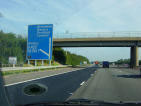 Precautions for Motorway Driving
Precautions for Motorway Driving Motorways have fewer accidents than any other type of road - BUT when they do occur they (not surprisingly) tend to be far more serious than accidents that occur when driving in towns and cities.
If you've passed your test it is only a matter of time before you'll need to go onto a motorway - my advice would be go with an experienced driver and practice (preferably when it's reasonably quiet) rather than find that when you have to use one that you've chosen to busiest day of the year to make your journey! Better still why not take that pass plus course that you've been putting off - you know it makes sense.
If you are still taking lessons with a driving instructor it is likely that you will encounter dual carriageways as part of your driving syllabus. All my pupils have some experience of driving on the A63 which has a 70 m.p.h. speed limit for quite long stretches and is very similar to motorway driving. I'd like to think that all the other driving schools in HULL do the same.
By sticking to a few simple rules, every motorway driver can make sure they
don't become involved in a dangerous situation on a motorway (or any other road).
First, what I always say to all my pupils is just as relevant to avoiding a collision on a motorway as any other road. There is no such thing as an accident. The common factors in all collisions are:
- 2 or more drivers.
- Arriving at the same place.
- At the same.
- And doing something they shouldn't - or not doing something they should!
And the easiest way to avoid this - Remove one of the above things - Yourself
 Scanning the road well ahead and behind is just as important when driving at high speeds - and the faster you're going the further you need to be looking. When things go wrong on fast moving roads the situation will change very quickly so we need as much warning as possible, take notice of the available information around use and use your anticipation skills.
Scanning the road well ahead and behind is just as important when driving at high speeds - and the faster you're going the further you need to be looking. When things go wrong on fast moving roads the situation will change very quickly so we need as much warning as possible, take notice of the available information around use and use your anticipation skills.
You can also do a great deal to protect yourself by being well prepared for your journey - look at the following points:
Before the journey:
- Make sure that your car is well-maintained and prepared for any journey.
- Key checks are that your vehicle has sufficient fuel and oil and that your
tyres are in good condition and of the correct pressure.
Under-pressurised tyres or cracked tyre walls are the primary causes of tyre
blowouts, and on a motorway this can cause you to lose control and result in
a serious accident. - Check out the route so you have a mental picture of your journey and keep up to date with road and weather conditions from local radio broadcasts.
When driving on the motorway, you should always observe the speed limit and
keep a safe distance between your vehicle and the car in front.
On a dry road and in good weather conditions, leave at least a two-second
gap between the cars, but at this time of year, when rain, snow and even ice
make the roads wet and slippery and also reduce visibility, you should leave
at least a four or five-second gap.
Read the Highway Code, Driving the Essential Skills and any of your driving instructors' handouts to remind yourself of the rules for motorway driving.
On the Motorway
- Take particular care when approaching intersections where traffic is joining
the motorway, and when you are joining motorways yourself. - Drivers joining the motorway should give way to those already on it.
Using your mirrors correctly and checking your blind spot when pulling out
is absolutely essential. - You should always observe lane discipline, too, and make sure that you
indicate when pulling out. - The left-hand lane of the motorway should be used whenever possible, and the middle and outside lanes for overtaking only.
- Never use the hard shoulder or move into a left hand lane in order to
overtake. - Accident levels rise during winter due to bad weather conditions,
because drivers fail to modify their driving habits accordingly. In foggy
conditions, slow down, and use your lights. - You should keep a sensible distance from the car in front, and in very bad
fog, open your window slightly so that you can listen out for other cars. - Safety on motorways is paramount during breakdowns. If you have a vehicle problem on the motorway, use the left indicator or hazard lights and move on to the hard shoulder if it's safe to do so.
- Keep your hazard warning lights on, and try to find the nearest emergency
telephone box, which are usually a mile apart. - If you need to walk to the phone, lock all of your doors and follow the
arrows on the roadside marker posts to the nearest phone. The phone calls are free and will connect you immediately to a police control room. - The phones will provide details of your exact location, so even if you have
a mobile, you should use the motorway emergency phone wherever possible. - When waiting for help, stand on the motorway embankment to avoid the danger of passing traffic.
